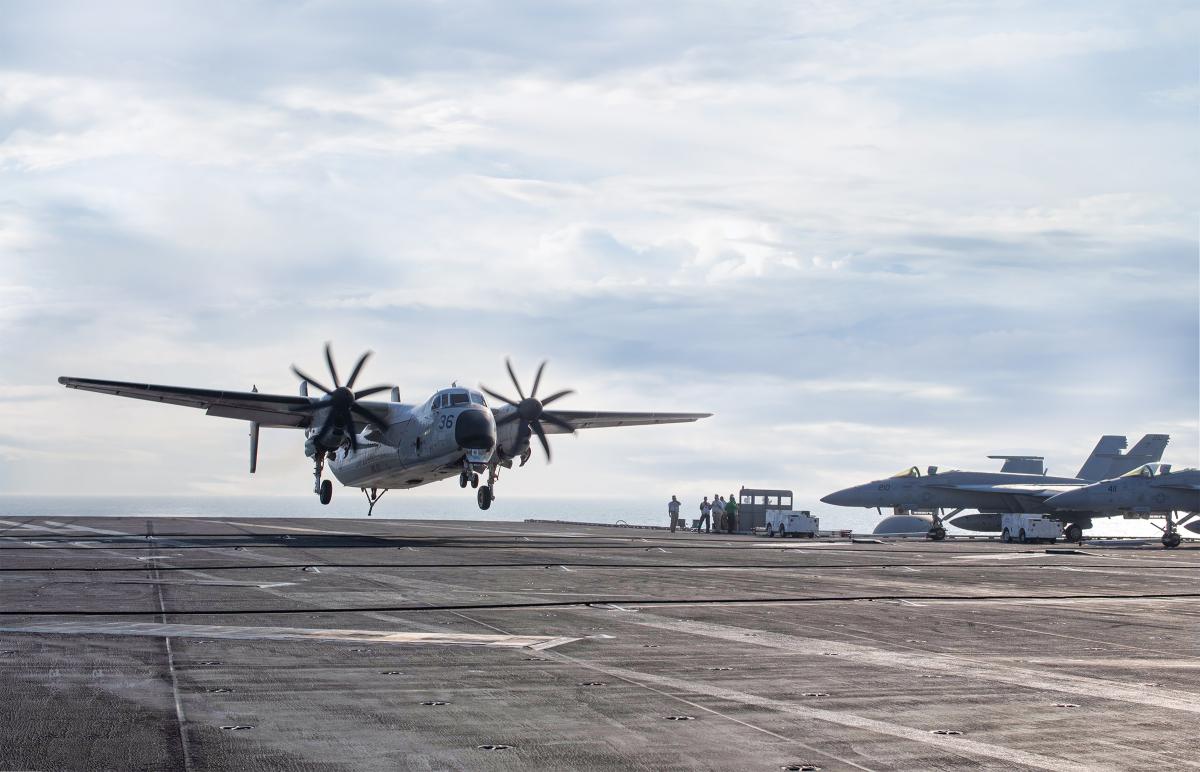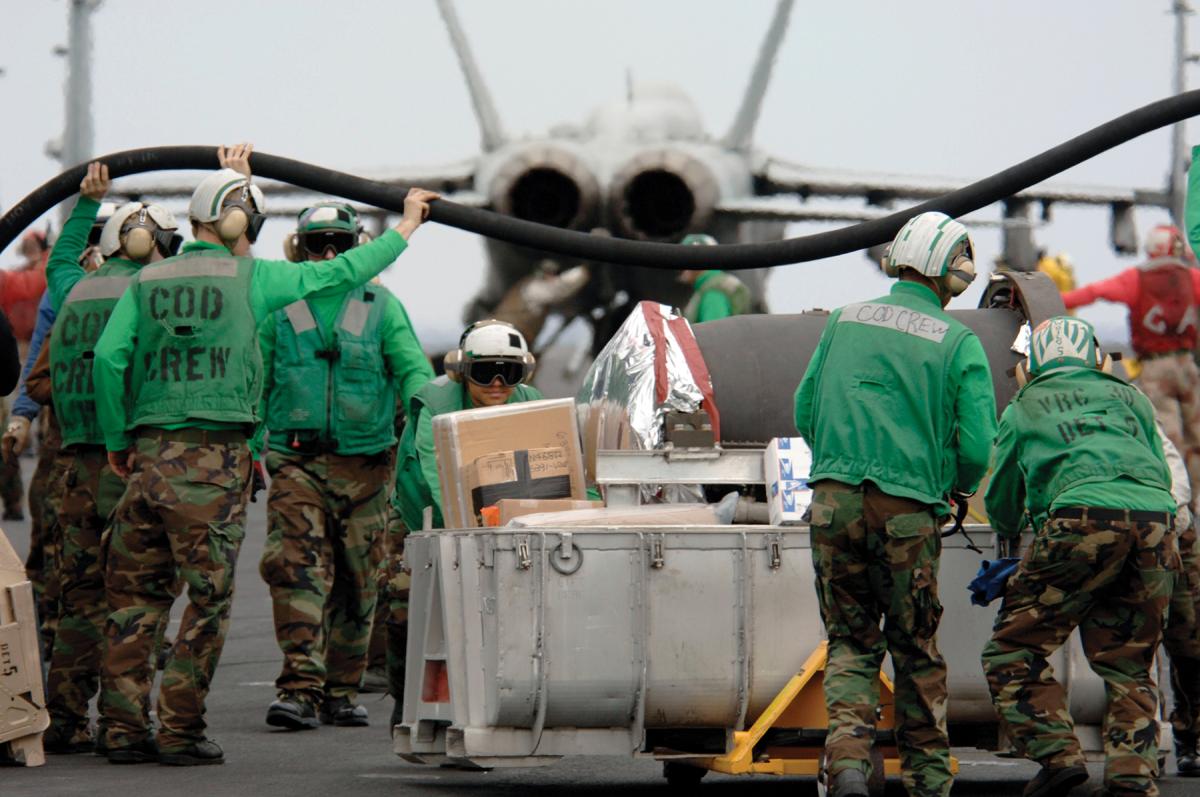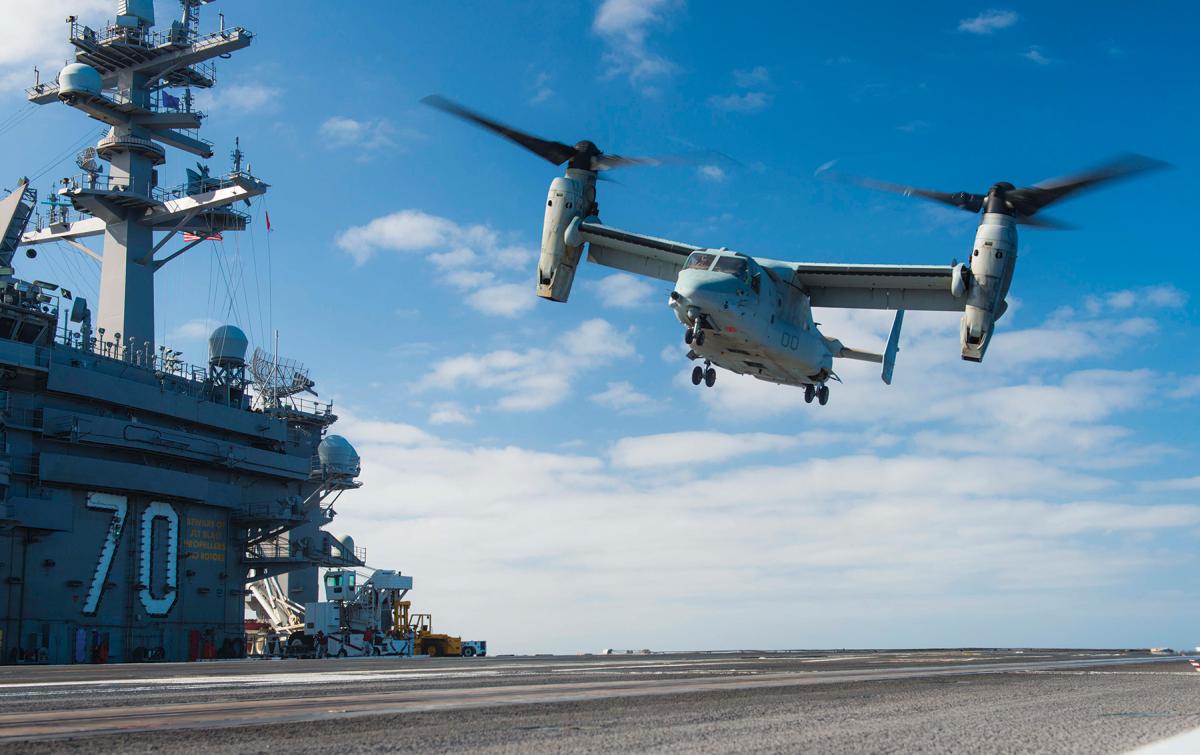“Geographic agility, where we’re going to places we haven’t been in a long time, [and] doing so a little less predictably, with fewer indicators in terms of where we’re going to go, is a big part of our business.”
Admiral John Richardson, 28 January 2019
Geographic agility is the strength of deployed carrier strike groups. Dynamic maneuver allows them to move within and between regions to project power and provide credible deterrence. However, dynamic maneuver depends on rapid logistics support—the sustained operations of carrier onboard delivery (COD) aircraft and the flow of high-priority parts and personnel they guarantee. The current logistics framework has been in stasis since the 1990s; it must adapt to support the Navy’s strategic vision.
Carrier Strike Group Logistics
Without the flow of fuel, weapons, parts, and people, a fully combat-capable carrier strike group (CSG) will begin degrading on departure from Norfolk or San Diego. Like aerial refueling, replenishment at sea is a force multiplier, extending the CSG’s warfighting capability by sustaining material readiness. Military Sealift Command ships pull into logistic ports, resupply, and leave to meet combatants at sea on a regular basis in every fleet area of responsibility. Supply chains are well established to support this effort. Ordering a part and having it delivered via replenishment at sea can be measured in weeks when ships operate in traditional operating areas.
When the CSG needs parts to fix critical casualties or return an aircraft to full mission capability or to bring a contract technician on board, the response must be measured in days. That has been possible because of CODs. Past predictable deployment schedules allowed operators to negotiate with host nations for the use of known airfields to met the needs of CSGs. Shore infrastructures pushed people and critical parts and supplies to the CSG in days. It was, and is, a system built on predictable operations timelines and geographic locations.
COD Operations
The responsiveness of COD detachments—enabling rapid delivery of high-priority items—is a significant factor in CSG logistical support. But their responsiveness is possible only if CSG operations are within range of suitable land-based airfields.
COD operations are enabled by CSG beach detachments of logistics and administrative professionals who work together at land-based sites to support planned operations. CSGs develop schemes of maneuver (SOMs) weeks or even months before operating within a specific fleet area of responsibility. Logistics planners then determine optimum COD operating locations, based on available host-nation support. Host-nation access is the result of negotiations by U.S. embassies and combatant commanders (supported by their Navy component fleet staffs). Without this integrated relationship, COD operations would not have access. Several factors go into selecting operating locations.
First is the “last mile” process of moving parts from shore to ship. Along with access granted by host nations, there are customs rules. These vary by country and differ depending on whether parts come in by way of civilian transport (FedEx/DHL) or military transport. Direct movement from U.S. military aircraft to COD aircraft with minimum host-nation delays is the ideal.
During a recent deployment, the John C. Stennis carrier strike group (CSG-3) encountered a wide range of customs clearance situations that ranged from direct movement without delay to delays of hours, days, and even weeks. CSG-3 also encountered inconsistent rules and processes between visits to the same location. Direct U.S. embassy involvement was required to maintain consistent logistics support.
Second is the “last mile” for people. Nations may require 30- to 180-day advance arrangements for U.S. military personnel or contractor transits to or from the CSG. CSG-3 encountered transit rules requiring applications for visas to enter or transit to be submitted from one day to six months in advance. In addition, military personnel movements are based on the Foreign Clearance Guide (FCG), which details what each country requires for entry and exit. Tickets for official travel are not issued unless those requirements are met. CSG-3 found the FCG was not always up to date, and some countries had “workarounds” that could be used to streamline processes. Ad hoc processes and outcomes resulted, as CSG-3 worked with U.S.-based travel representatives to manage personnel movements.
Third is the ease of routine airfield operations. An airfield may provide an ideal location for easy movement of people and parts, but if local rules restrict access to aircraft or flexibility for maintenance, CSG support suffers. Around-the-clock security, maintenance access, and processing of people and material is the ideal. CSG-3 experienced airfield inflexibility on all issues and had to adjust its SOM to accommodate individual airfield hours and closures. Ultimately, limited airfield access can add days to high-priority deliveries.
Fourth is airfield locations in relation to expected CSG operating areas. CODs, like all naval aviation, operate with safety margins for fuel during flights over water. Range can be extended by using a “lily pad” (an airfield between temporary logistics sites and ships). CSG-3 experienced tension between executing mission tasks requiring a specific operating location and COD staging locations, requiring it to break presence, receive COD support, and then return to its mission.
Fifth is the Aircraft and Personnel Automated Clearance System (APACS) process. The State Department and the Navy negotiate with sovereign nations to allow movement of aircraft through their airspace. Lessons learned from CSG-3 and prior COD detachments indicate most countries require 30 days for approval of all APACS requests. If CSG operations require shorter timelines and more flexibility, U.S. embassies and the Navy ask for waivers to ensure continued access. While deployed, dynamic force employment tasking shifted CSG-3’s SOM with less than 72 hours’ notice. This negated a planned long-range COD self-transit across multiple countries, and required a new request to remain at the current location for continued logistics support. This change request required flag staff and commanders’ action for approval on the compressed timeline.
All these factors determine optimal COD detachment locations to support CSG operations. They are simpler problems in areas where the Navy has become “predictable.” CSG-3 operations in well-established areas, for example, were enabled by years of previous cooperation. In Seventh Fleet, operations that were planned far in advance and executed in proximity to long established COD operating locations were routine. However, short-notice changes in operating locations stressed COD support. Missions that involved multiple days away from COD support required trade-offs between continued operations with declining readiness and breaks in presence.
Friction Points
Prior to deployment, CSG-3’s COD detachment used its expected SOM to plan optimum locations for COD operations. Adjustments to the SOM were accompanied by detachment updates and APACS clearances. Dynamic maneuver exposed friction points with COD support.
Downstream Effects of SOM Changes
CSG-3 planned multiple transitions between fleet areas of responsibility, which required submitting APACS requests for each relocation and new clearances 30 days before operations. Expected lily-pad locations were included to support maneuver. But any shift in planned CSG tasking and SOM inside that time frame meant amendments, cancellations, and new requests to different host nations. Each shift required restarting the process in each nation. Getting changes made within previous timelines required numbered-fleet country desk assistance, embassy intervention, and host-nation ministry support.
Messaging
CSG-3 was tasked with exercising a new temporary logistics site (COD base of operations) in an area traditionally void of support. This proof of concept involved moving parts into the country via military channels and commercial shipping, then moving the material to the CSG via COD. This was an example of the importance of strategic messaging by the State Department and the Navy as part of a diplomatic process with a sovereign nation on issues of routine access. Shortly after initial demonstration, the host nation considered limits and changes for future operations, and combined embassy country team and Navy efforts continue to develop the cooperation necessary for continued access.
Numbered Fleet Support
Dynamic maneuver and geographic agility are designed to increase adversaries’ uncertainty about where and when U.S. naval forces will be able to establish presence. To achieve that, the Navy will have to match logistics capabilities with the demand for increased mobility and flexibility. CODs require a fleet-based infrastructure with essential capabilities for future support.
Numbered-fleet staffs have regional expertise, connections to embassies, and enduring relationships with host nations. They are the natural partners to support State Department negotiations for longer-term, more flexible agreements for COD access. Agreements could normalize rules and processes for access and use of land-based locations for multiple years. A key objective would be to improve responsiveness to short-notice changes in access for specific parts and people movements or dates required for overflight. No CSG can match fleet capabilities in these areas.
Fleets could coordinate CSG movements with other forces, nested within a regional logistics strategy. Fleet logistics task forces have the operational control to position and plan operations using CODs, logistics force support, and port visits. This could avoid current stresses on CSGs to manage these processes, especially when trying to maximize the dynamic maneuver of the CSG on short notice.
Movements across fleet boundaries make these issues more complicated. CSGs cannot align processes for support to operations when they may be tasked with missions that require frequent or rapid movements across areas of responsibility. Pacific Fleet and Fleet Forces Command can facilitate numbered fleet alignment so forces can operate globally, with sustained capabilities (mission-capable aircraft, full spectrum capable ships, and operating information systems). There will not be time for each CSG to manage myriad, rapidly changing COD locations; it is a job for fleets as part of a theater-wide effort.
Replacement of the C-2 with the CMV-22B will not resolve the issues illustrated here. In fact, the CMV-22B’s shorter range and smaller capacity will increase the need for access and agility, and its different airfield compatibility, maintenance requirements, and operational usage will demand more engagement with host nations to develop future theater logistics plans. Embassy country teams and fleets will be called on to stand up this new infrastructure at the same time they must expand it beyond traditional boundaries to support dynamic maneuver.
Increased agility is an integral part of great power competition against globally capable adversaries. Navy carrier strike groups require flexible and scalable COD sustainment to maintain their power. Numbered fleets and U.S. embassies must work with partner nations to increase responsiveness in supporting COD operations and help the Navy meet the call for future presence and crisis response operations.





